How “The Penguin” Production Designer Kalina Ivanov Helped Bring Gotham Back to New York City
Production designer Kalina Ivanov was destined to be part of the HBO spin-off series The Penguin from creator Lauren LeFranc, which stars Colin Farrell as the title character, Oz Cobb, reprising his role from Matt Reeves’ The Batman and remaining, once again, utterly unrecognizable.
“The very first movie I saw in the theater after Covid stopped being Covid was The Batman, and I loved it,” Ivanov says. “I saw it in March, and then I got a call in May asking if I’d be interested in interviewing for The Penguin. And I said, oh my god, that is just phenomenal because out of all the characters that are comic book characters, Batman is my favorite and everything that has to do with Batman.”
The Penguin picks up after the events of Reeves’s gothic, gorgeously constructed The Batman, which pitted Robert Pattinson’s Batman against Paul Dano’s the Riddler, with Farrell’s gangster stealing every scene he was in. [For a peek at one of the best scenes in The Batman, check out this chase between Batman and the Penguin.)
The Penguin‘s narrative follows the rise of the devious mobster in an eight-part bingeable series that is more a character study of how The Penguin came to be and what he plans to do in a Gotham now short the former reigning gangster king, Carmine Falcon (played in the film by John Turturro), than an action-filled comic book movie. The introduction of new characters like Sopfia Falcone, Carmine’s daughter, brilliantly played by the scene-stealing Cristin Milioti, and Victor (Rhenzy Feliz), an impressionable teen who ends up being Cobblepot’s driver, add a rich dimension to The Penguin’s storyline that explores his backstory.
In creating the dynamic settings of the series, Ivanov first spoke with LeFranc and executive producers Matt Reeves, Dylan Clark, and Bill Carraro about designing an entirely new world for the Batman ethos. Below, she details how she conjured a dilapidated Gotham in the backdrop of a vibrant and very real New York City.
An ambitious project like The Penguin doesn’t happen often. Did anything initially stand out about it to you?
Lauren’s writing is so beautiful. Right away, I could tell that they were taking a new approach and a new direction with the character and the visuals and what part of the city they were going to show. My biggest concern was how do you continue a movie that was shot in England and Liverpool, and you are now doing it in New York.
So what was that like, going from re-conjuring Gotham from The Batman, shot in England, to the city that’s always been Gotham’s real-life inspiration, New York?
England and New York are very different architectural vernaculars, right? So we had great conversations with Matt Reeves, Dylan Clark, Bill Carraro, and Lauren [LeFranc] about how to build our own universe. What exactly is the universe? What is the neighborhood? What is the world that the Penguin embodies? And where does he go? And it was very clear that they wanted to show Crown Point, and they wanted to kind of dwell on the lower depths of Gotham, not so much the fancy part of Gotham and or the Batman world of Gotham. So that was very liberating because that allowed us to create a whole new look.
This series is grittier than the more polished Batman films—even Matt Reeves’ decidedly street-level, darker film. Did you reference any material outside the comic books or previous films to develop the look?
Matt Reeves told us, which was very important to him and Lauren, that we should look at French Connection and be very inspired by the visual language of The French Connection and how that can translate into Gotham and how to use New York as our Gotham. That was extremely influential on the look because it immediately put us underneath tresses, subways, and arches. And we looked for so many underpasses of any kind we can imagine. And it became kind of the show’s vernacular and a great starting point to start building our Gotham.
How much did you work with local vendors in and around New York?
We worked with NYC Film Office and Film Yonkers, and we worked with so many local vendors. First of all, you want to help the city and want to help the vendors, prop houses, and everyone. We always work with Roscoe, which is around New York, and we have our own art department vendors. We’re very much involved with trying to help the economy of New York. And all the locations help because so much of the specific look for us was spending more time in Yonkers and the Bronx and less time in Manhattan.
The series picks up after The Riddler bombs Gotham in The Batman. Part of the opening sequence, Oz enters the Iceberg Lounge. Did you recreate its exterior from The Batman?
The exterior had to be a recreation, so what we did is we found a really great location in New York, which is not under a subway, but it’s actually the West Side Highway. I think 138th Street, exactly. We built the front entrance there. We had the drafting from the movie, and we recreated the entrance, but we broke the letters and we broke the awning because that all would have been broken by the flood. But then that location had the big giant tunnel, too, where we created this mass of debris and piles of broken cars. You’re really trying to set the tone of the series, and the tone that you’re going to see is this city in complete decay.
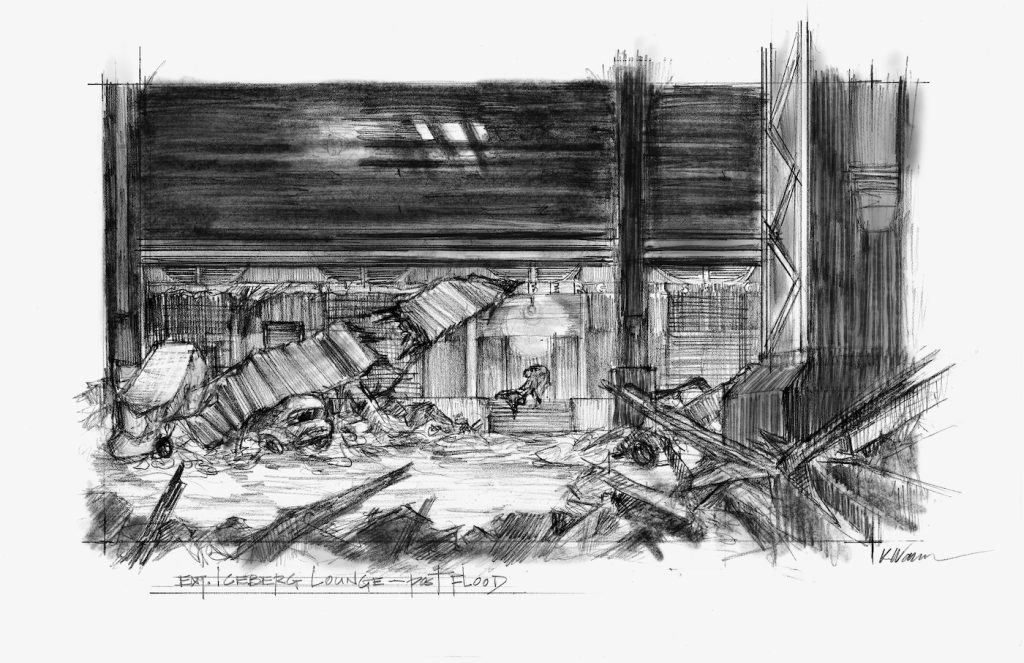
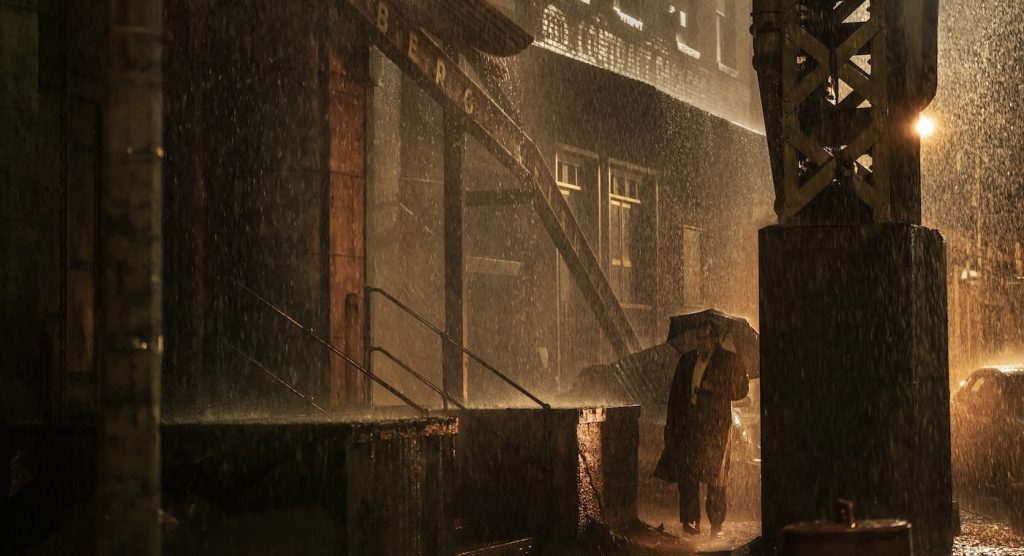
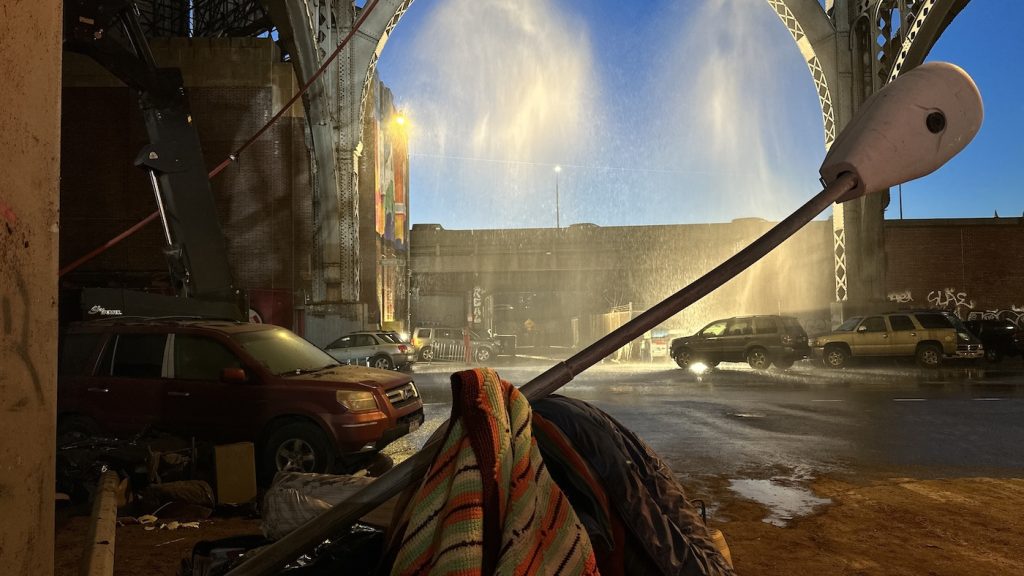
When The Penguin enters the Iceberg Lounge, he ends up in a room we haven’t seen before. How did that come about?
Recreating the inside of the lounge was almost beyond our budget in a sense. So, we agreed to create a new environment that we had not seen, and that captured the spirit of the movie’s design. And so, it was a great opportunity for me because what I said to them is, okay, if Carmine [Falcone, played in flashbacks in The Penguin by Mark Strong] never goes to his mansion, and he’s always at the club working, he must have a flawed relationship with his family. So, if he’s a workaholic, he must have a bedroom adjacent to his club when he stays in town, right? Basically, like his quarters, his bachelor quarters. And that’s what we pitched to Matt, and the interior ended up being his bedroom, literally offsite from the lounge.
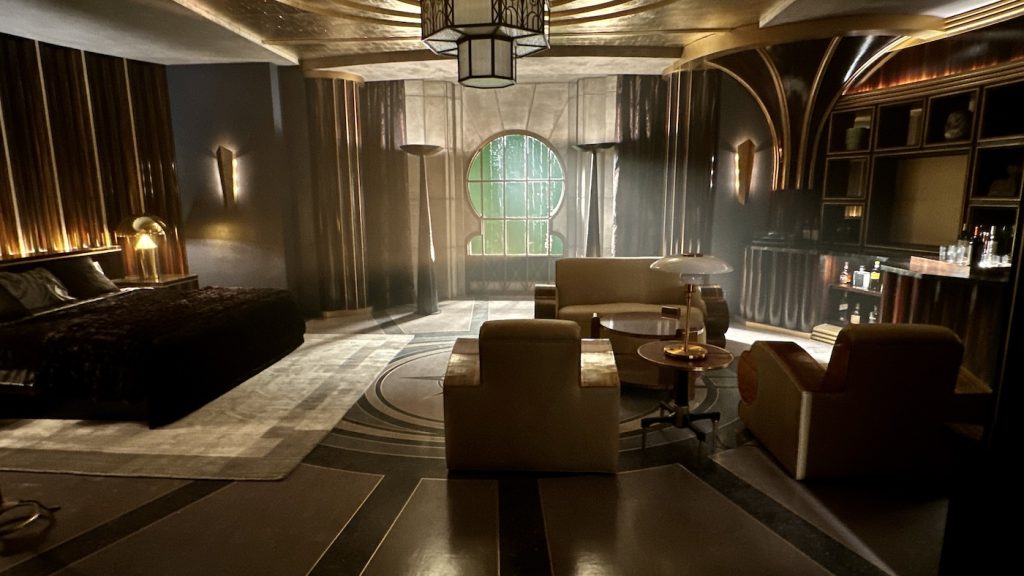
Well, you really made it feel like it was part of the movie.
Thank you. What helped was that I tried to capture the spirit of one of the windows. And I remember showing the set; it was one of the first sets we shot when the studio executives came, and they loved it because it had this gold ceiling and everything. With Carmine, it will be tasteful but a little bit in your face. But the important part about it is that it had to be tasteful because when you see The Penguin, you see how he wants to be Carmine, but he doesn’t have taste. So, it became a very interesting way to start contrasting these two gangsters.
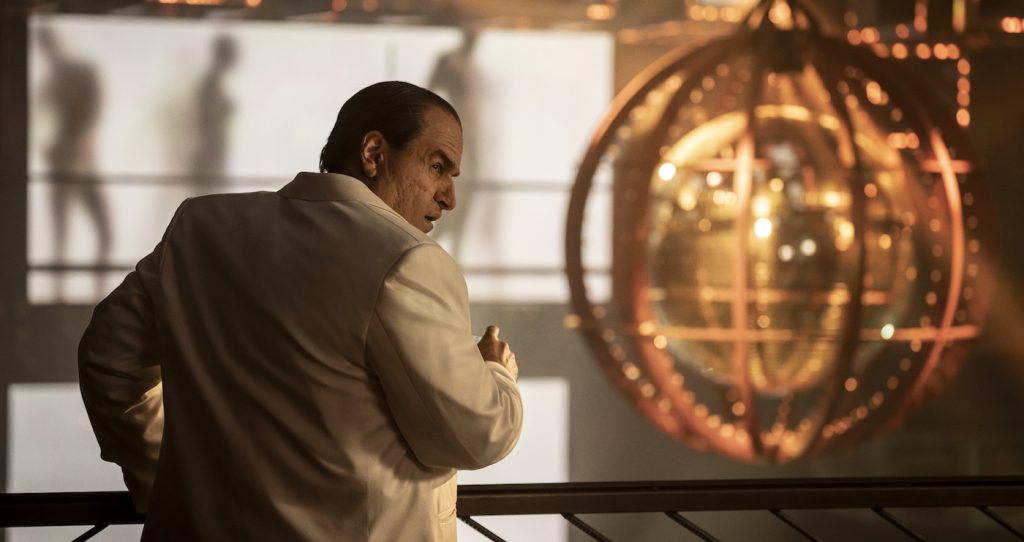
When we see the Penguin’s place in the Diamond District, we can see the contrast between Carmine’s and Oz’s tastes. How did you approach his living space?
That’s a classic example of taking something very real and elevating it in a sense. So, when I read that he lived in the Diamond District, it was very important for us that he was on the lower floor because there’s a story point where, as he rises, his living quarters will rise too. So, it was very important story-wise that he starts not exactly at the bottom, but he isn’t at the top yet. He’s not Carmine. So, because he was set in the Diamond District, I pitched the idea that he actually transformed a jeweler’s repair shop into his loft. If people start freeze framing, they will see that we actually printed an article about the jeweler who used to have his business there. We created that jewelry business basically and there’s a reference to the history of it. That’s how deep we went into it.
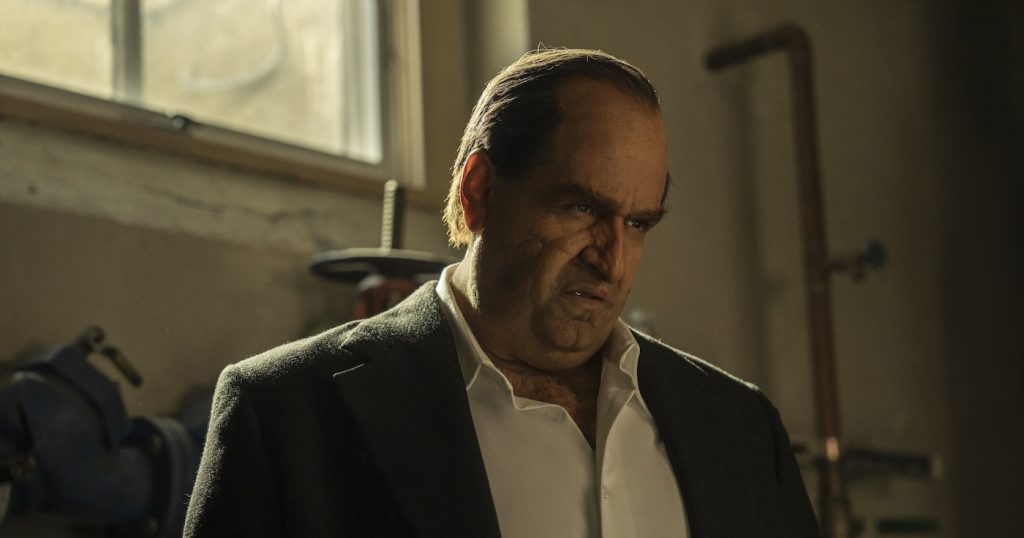
The touches of metal add a lot to the feel of the space, too.
The metal is so cold, and that character has a very calculated coldness. Yet, the Penguin can be so warm on the outside and be Victor’s father figure. And so, you have this wonderful combination of brick on one side and then the metal on the other. Thematically, it was really, really important to us.
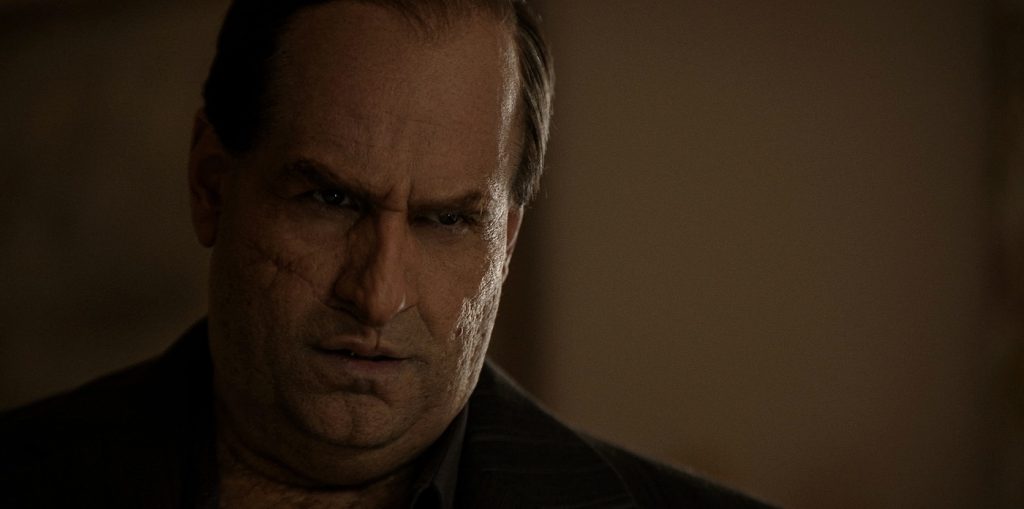
Since you mentioned themes, the color palette has a unique style. Do you have a reference point for it?
I really loved this kind of palette because if you think about it, it captures what a comic book is like, which is a very high contrast. So, even though I didn’t approach this like doing a comic book, I wanted to have some of the essence of the beauty of the comic books because they’re beautifully drawn. There’s a specific comic book from the 80s that Matt based The Batman on. So, that was a pretty good reference in terms of what kind of style of New York he wanted because New York was still very decrepit. It’s not that really shiny New York that it is now; it’s all stores, clothing stores, and very, very, very wealthy people everywhere. It was really a lot of graffiti and decay. It was building itself up. So, it was an interesting visual point. And I think that the palette followed the movie in many ways, but it definitely had more color than the movie because we were in so much more vibrant neighborhoods
Speaking of neighborhoods, Crown Point becomes an intricate part of the series. How did you want to treat the neighborhood after The Riddler’s bombing?
The Penguin comes from that neighborhood, and where he grew up is the neighborhood adjacent to it. So, we created a map of Gotham and a map of Crown Point. The important part of Crown Point was that it was extremely damaged by the flood due to the bombs [that the Riddler set there]. So, we used all of these references, including Hurricane Katrina. We actually used real FEMA charts to show how they labeled defunct buildings. Our map showed the flooding from level five to level one and when we would have more and when we would have less. It was very thought out throughout the vision of the series, not just part of the visual art but the show’s storyline.
The Penguin premieres September 19 on HBO.
Featured image: Colin Farrell. Photograph by Courtesy of Max



